
Millom is a town and civil parish on the north shore of the estuary of the River Duddon in southwest Cumbria, historically part of Cumberland, England. It is situated just outside the Lake District National Park, about six miles north of Barrow-in-Furness and 26 mi (42 km) south of Whitehaven.

Barrow-in-Furness is a port town in Westmorland and Furness, Cumbria, England. Historically in Lancashire, it was incorporated as a municipal borough in 1867 and merged with Dalton-in-Furness Urban District in 1974 to form the Borough of Barrow-in-Furness. In 2023 the borough merged with Eden and South Lakeland districts to form a new unitary authority; Westmorland and Furness. At the tip of the Furness peninsula, close to the Lake District, it is bordered by Morecambe Bay, the Duddon Estuary and the Irish Sea. In 2011, Barrow's population was 56,745, making it the second largest urban area in Cumbria after Carlisle, and the largest in Westmorland and Furness. Natives of Barrow, as well as the local dialect, are known as Barrovian.
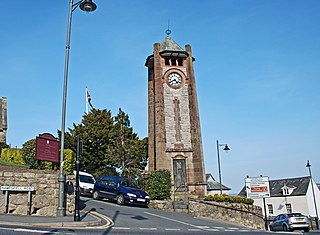
Grange-over-Sands is a town and civil parish located on the north side of Morecambe Bay in Cumbria, England, a few miles south of the Lake District National Park. In the 2001 census the parish had a population of 4,042, increasing at the 2011 census to 4,114. Historically part of Lancashire, the town was created as an urban district in 1894. Since the 1974 local government re-organisation, it has been of the South Lakeland district of Cumbria, though it remains part of the Duchy of Lancaster.

Holker Street,, is a sports stadium in Barrow-in-Furness, Cumbria, England. As well as being a football ground, it has also been used for motorcycle speedway. It once had some leisure centre facilities, including four squash courts, which have now been demolished. Its owners, and tenants for the majority of its history, are Barrow A.F.C., who have played at the ground since 1909. Despite its current capacity being just over 5,000, some 16,874 crammed the stadium in 1954 when Barrow played Swansea Town in the FA Cup third round.

Roose or Roosecote is a suburb and ward of Barrow-in-Furness, Cumbria, England. The word 'roose' is Celtic for "moor" or "heath" and the suffix 'cote' of Roosecote means "hut" or "huts". Before the building of Roose Cottages and the arrival of the Cornish miners Roose was pronounced with a hard S, as in goose; now it is locally pronounced 'Rooze', due to the Cornish accent. Roose is served by Roose railway station, one of the few remaining stations on the Furness Line in the Barrow area.

Barrow Island is an area and electoral ward of Barrow-in-Furness, Cumbria, England. Originally separate from the British mainland, land reclamation in the 1860s saw the northern fringes of the island connected to Central Barrow. Barrow Island is also bound to the south and east by the town's dock system and to the west by Walney Channel. The Ward population taken at the 2011 census was 2,616.

Holker Old Boys Association Football Club is an amateur football club based in Barrow-in-Furness, Cumbria, England. They are currently members of the North West Counties League Division One North and play at Rakesmoor Lane.

Kirkby-in-Furness, generally referred to simply as Kirkby locally, is a village in the Furness area of Cumbria, England. Historically part of Lancashire, it's located close to the Lake District National Park. It is about 3 miles (5 km) south of Broughton in Furness, 5 miles (8 km) northwest of Ulverston and 9 miles (14 km) north of Barrow-in-Furness. It is one of the largest villages on the peninsula's north-western coast, looking out over the Duddon estuary. In 2019 it had an estimated population of 563.
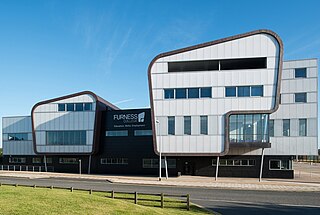
Furness College is a college of further education in Barrow-in-Furness, Cumbria. It provides a wide range of A levels, vocational education and skills training to over 16s, notably working with BAE Systems to train apprentices for their shipyard in Barrow. The college also offers courses for adults, and runs HNDs and other higher education programmes including foundation degrees, degrees and master's degrees, for which it achieved Teaching Excellence Framework silver status in June 2017. It is the only college in Barrow and the largest further education college in Cumbria. On 1 August 2016, Furness College merged with Barrow Sixth Form College.

Barrow Sixth Form College, part of Furness College, is in the outskirts of Barrow-in-Furness, Cumbria, England. Barrow Sixth Form College was established in 1979 to fulfil the role of the main A level provider in Barrow following the merger of the two Barrow Grammar Schools and their change to deliver education to only 11 to 16 year-olds. It is the only sixth form college in Cumbria. A levels and Cambridge Technical qualifications are taught in buildings that have been specially designed for students over the age of sixteen. It includes facilities for physically disabled students and is a satellite campus for Beaumont. The college primarily educates students within the age range of 16–18 years, as well as courses for adult learners.
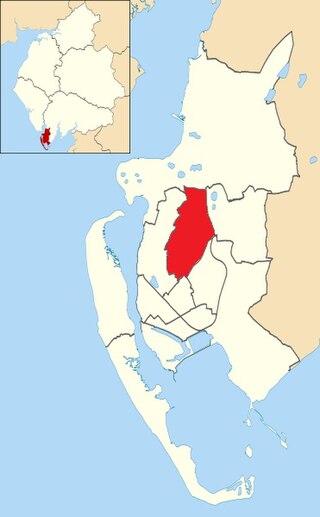
Hawcoat is an area and electoral ward of Barrow-in-Furness, Cumbria, England. Historically part of Lancashire, it is one of Barrow's most northerly wards and is bordered by Roose, Newbarns, Parkside, Ormsgill and the town of Dalton-in-Furness to the north.
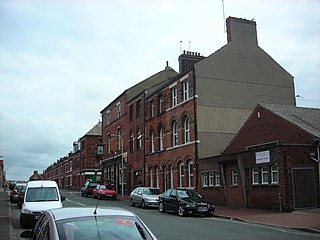
Hindpool is an area and electoral ward of Barrow-in-Furness, Cumbria, England. It is bordered by Barrow Island, Central Barrow, Ormsgill, Parkside and the Walney Channel, the local population stood at 5,851 in 2011. The ward covers the entire western half of the town centre and includes Barrow's main shopping district. Other local landmarks include the Furness College Channelside campus, the Dock Museum and the Main Public Library. Hindpool is also home to two stadia - Barrow Raiders' Craven Park and Barrow A.F.C.'s Holker Street.

Abbey Road is the principal north to south arterial road through Barrow-in-Furness, Cumbria, England.
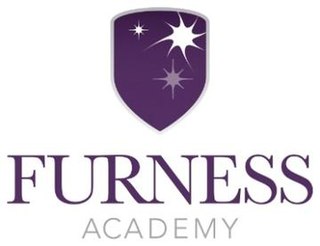
Furness Academy is a secondary school in Barrow-in-Furness, England. It is the fourth academy to have been formed in the county of Cumbria after the closure of Alfred Barrow School, Parkview Community College of Technology and Thorncliffe School in 2009. Having utilised numerous buildings of the former Parkview and Thorncliffe Schools since 2009, a single £22 million building opened in the Parkside area of the town in September 2013.

Barrow-in-Furness Main Public Library is a Grade II listed Beaux-Arts style building located at Ramsden Square, Barrow-in-Furness, England. Operated since 1974 by Cumbria County Council, it is the largest library in the town and the present structure, designed by J A Charles was originally built as a Carnegie library with support from the Carnegie Foundation.

The Devonshire Buildings are two adjacent apartment buildings in the Barrow Island area of Barrow-in-Furness, Cumbria, England. They are both recorded in the National Heritage List for England as designated Grade II* listed buildings.
The Ritz was a cinema located at the junction of Abbey Road and Holker Street in Barrow-in-Furness, Cumbria, England. The building was designed in a typical Art Deco-style by architect firm Drury & Gomersall and constructed in 1936 on a previously undeveloped site. Between 1961 and 1977 it was known simply as the ABC; after ABC Cinemas who took over ownership of the premises soon after completion. This changed to the Astra when the venue was bought by Hutchinson Leisure. In this period the cinema was completely refitted, adding two extra screens to the existing one. The largest of the screens seated 640 while the smaller two seated 260 each.
The Barrow Grammar Schools were two adjacent single-sex education schools in Barrow-in-Furness, Lancashire, England during the 20th century. Both schools merged in 1979 to form the co-educational Parkview Community College of Technology. Parkview School itself was merged in 2012 with Thorncliffe School and Alfred Barrow School to form Furness Academy. Parkview School and all elements of the former Grammar Schools were demolished in 2014 with a new school building for Furness Academy being constructed in the playing fields of Parkview.
Alfred Barrow Health Centre is a primary care health centre in Barrow-in-Furness.
















